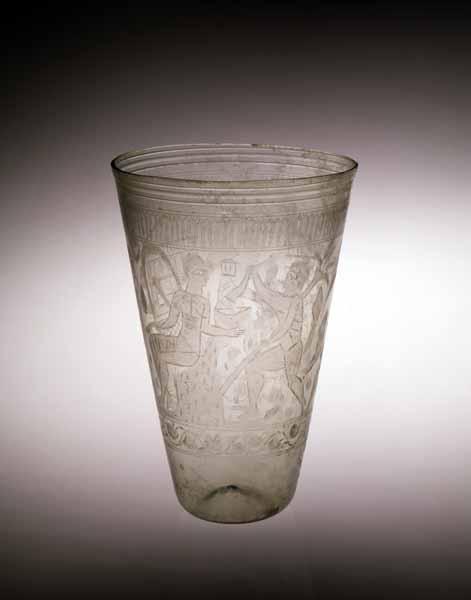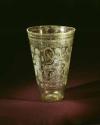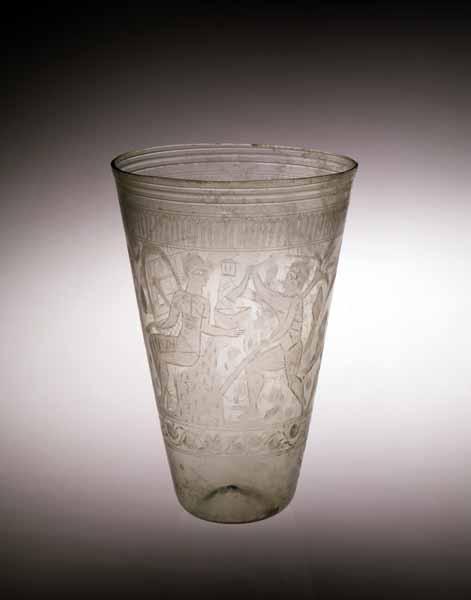Beaker with Bacchic Imagery
Date: Late 3rd to mid-4th century CE
Dimensions:
H: 8 in. (20.2 cm)
Medium: Colorless glass; free-blown, wheel-engraved
Place of Origin: Ancient Rome, from Worringen (near Cologne), Germany
Classification: Glass
Credit Line: Purchased with funds from the Libbey Endowment, Gift of Edward Drummond Libbey
Object number: 1930.6
DescriptionEngraved scene showing Palatine Hill with five personages and many still life figures;
Thin glass. Small ovoid and spherical bubbles.
Transparent decolorized glass with a grayish yellow green tinge (5 GY 7/2).
Free-blown. No pontil mark. Exterior surface design abraded (mattschliff) and wheel-cut.
Slightly convex ground rim. Inverted conical body with straight sides tapering to base. Concave base.
Around upper three-quarters of body, a ground and wheel-cut figural scene framed above and below by subsidiary decorative zones. From top to bottom: three deep wheel-cut grooves, a band of spikes in double outline framed above and below by two narrow wheel-cut lines, a tall figural zone, and a vegetal band framed above and below by two narrow wheel-cut lines. The figural band is divided into two scenes. The first consists of three figures in a natural setting. From left to right: a barefoot woman (1) in a long sleeveless dress seated to left on a boulder, looking back over her left shoulder. The space around her is filled with an abraded oval above her right arm and a criss-crossed diamond near her left shoulder, behind her head is a fill ornament in the form of an architectural structure made up of eight short vertical lines (columns) framed between bands of two horizontal lines with an abraded semi-circle (dome) resting on top (giving the appearance of a domed colonnaded building); directly to the right and left of her head, festoons rendered by vertical strokes that appear to be suspended from the decorative band above; there is an abraded square in the center of the garland to the right. Seated to the left on a large boulder is a second female figure characterized as more important by her greater size (2). She too is barefoot and wears a long, short-sleeved garment, but coquetishly bares her left leg while looking back over her left shoulder toward a male nude (3). In her right hand she holds the end of a fringed fillet which arches up to head level and disappears behind her right shoulder. In the space between fillet and body is an oblong element (possibly the other end of the fillet) which passes behind her body. In her left hand she extends a large hemispherical cup. To the right of her head is a second, smaller architectural fill ornament consisting of four vertical lines (columns) framed by horizontal lines with an abraded triangular pediment. Facing her is a standing male figure (3) with his right leg bent forward and his right foot resting on a rectangular block adjacent to the large boulder. He pours into the bowl held by figure (2) from a large horn-shaped vessel in his raised right hand while using his left hand to stady the trunk of a small palm tree with four branches against his right knee; the tree passes awkwardly behind his body and reappears behind his head. Three abraded round and three rectangular fill ornaments dot the space between figures (2) and (3) while two more abraded roundels and one criss-crossed diamond fill ornament are between his legs. Two sea creatures: a squid made up of an abraded diamond from which trail four vertical linear elements and a fish made up of incised lines belong to the second scene but also acts as a division between the two scenes. The second scene consists of two naked, winged figures (4, 5) who reach toward each other over a large storage jar which is topped by a shallow semi-circular bowl. Both figures wear quivers, the straps of which are visible across the chest; the quiver itself may be visible on figure (5) above his right shoulder. Between them at head level is an architectural fill ornament consisting of five vertical lines (columns) framed by two horizontal bands with diagonal lines pointing outward from the upper corners (akroteria or wings) with an abraded semi-circle resting on top; the structure may represent a circular monopteros. Surrounding it are an abraded round fill ornament and four quadrilateral fill ornaments, three of which are divided into quarters and one of which is criss-crossed. Between the legs of figure (4) is another quartered quadrilateral and between the legs of figure (5), an abraded roundel. To the right and left of the top of the wing of figure (5) hang a garlands. Separating the second scene from the first scene is a tall, narrow, multi-storeyed building with an arcaded entrance on the first floor, ashlar masonry and a large grill-work window on the second, two small rectangular windows on the third floor, and a (loggia?) colonnade on the fourth; it looks like a Roman granary or horrea. The vegetal zone below the figural band consists of a garland of circular fruit.
Thin glass. Small ovoid and spherical bubbles.
Transparent decolorized glass with a grayish yellow green tinge (5 GY 7/2).
Free-blown. No pontil mark. Exterior surface design abraded (mattschliff) and wheel-cut.
Slightly convex ground rim. Inverted conical body with straight sides tapering to base. Concave base.
Around upper three-quarters of body, a ground and wheel-cut figural scene framed above and below by subsidiary decorative zones. From top to bottom: three deep wheel-cut grooves, a band of spikes in double outline framed above and below by two narrow wheel-cut lines, a tall figural zone, and a vegetal band framed above and below by two narrow wheel-cut lines. The figural band is divided into two scenes. The first consists of three figures in a natural setting. From left to right: a barefoot woman (1) in a long sleeveless dress seated to left on a boulder, looking back over her left shoulder. The space around her is filled with an abraded oval above her right arm and a criss-crossed diamond near her left shoulder, behind her head is a fill ornament in the form of an architectural structure made up of eight short vertical lines (columns) framed between bands of two horizontal lines with an abraded semi-circle (dome) resting on top (giving the appearance of a domed colonnaded building); directly to the right and left of her head, festoons rendered by vertical strokes that appear to be suspended from the decorative band above; there is an abraded square in the center of the garland to the right. Seated to the left on a large boulder is a second female figure characterized as more important by her greater size (2). She too is barefoot and wears a long, short-sleeved garment, but coquetishly bares her left leg while looking back over her left shoulder toward a male nude (3). In her right hand she holds the end of a fringed fillet which arches up to head level and disappears behind her right shoulder. In the space between fillet and body is an oblong element (possibly the other end of the fillet) which passes behind her body. In her left hand she extends a large hemispherical cup. To the right of her head is a second, smaller architectural fill ornament consisting of four vertical lines (columns) framed by horizontal lines with an abraded triangular pediment. Facing her is a standing male figure (3) with his right leg bent forward and his right foot resting on a rectangular block adjacent to the large boulder. He pours into the bowl held by figure (2) from a large horn-shaped vessel in his raised right hand while using his left hand to stady the trunk of a small palm tree with four branches against his right knee; the tree passes awkwardly behind his body and reappears behind his head. Three abraded round and three rectangular fill ornaments dot the space between figures (2) and (3) while two more abraded roundels and one criss-crossed diamond fill ornament are between his legs. Two sea creatures: a squid made up of an abraded diamond from which trail four vertical linear elements and a fish made up of incised lines belong to the second scene but also acts as a division between the two scenes. The second scene consists of two naked, winged figures (4, 5) who reach toward each other over a large storage jar which is topped by a shallow semi-circular bowl. Both figures wear quivers, the straps of which are visible across the chest; the quiver itself may be visible on figure (5) above his right shoulder. Between them at head level is an architectural fill ornament consisting of five vertical lines (columns) framed by two horizontal bands with diagonal lines pointing outward from the upper corners (akroteria or wings) with an abraded semi-circle resting on top; the structure may represent a circular monopteros. Surrounding it are an abraded round fill ornament and four quadrilateral fill ornaments, three of which are divided into quarters and one of which is criss-crossed. Between the legs of figure (4) is another quartered quadrilateral and between the legs of figure (5), an abraded roundel. To the right and left of the top of the wing of figure (5) hang a garlands. Separating the second scene from the first scene is a tall, narrow, multi-storeyed building with an arcaded entrance on the first floor, ashlar masonry and a large grill-work window on the second, two small rectangular windows on the third floor, and a (loggia?) colonnade on the fourth; it looks like a Roman granary or horrea. The vegetal zone below the figural band consists of a garland of circular fruit.
Not on view
In Collection(s)




